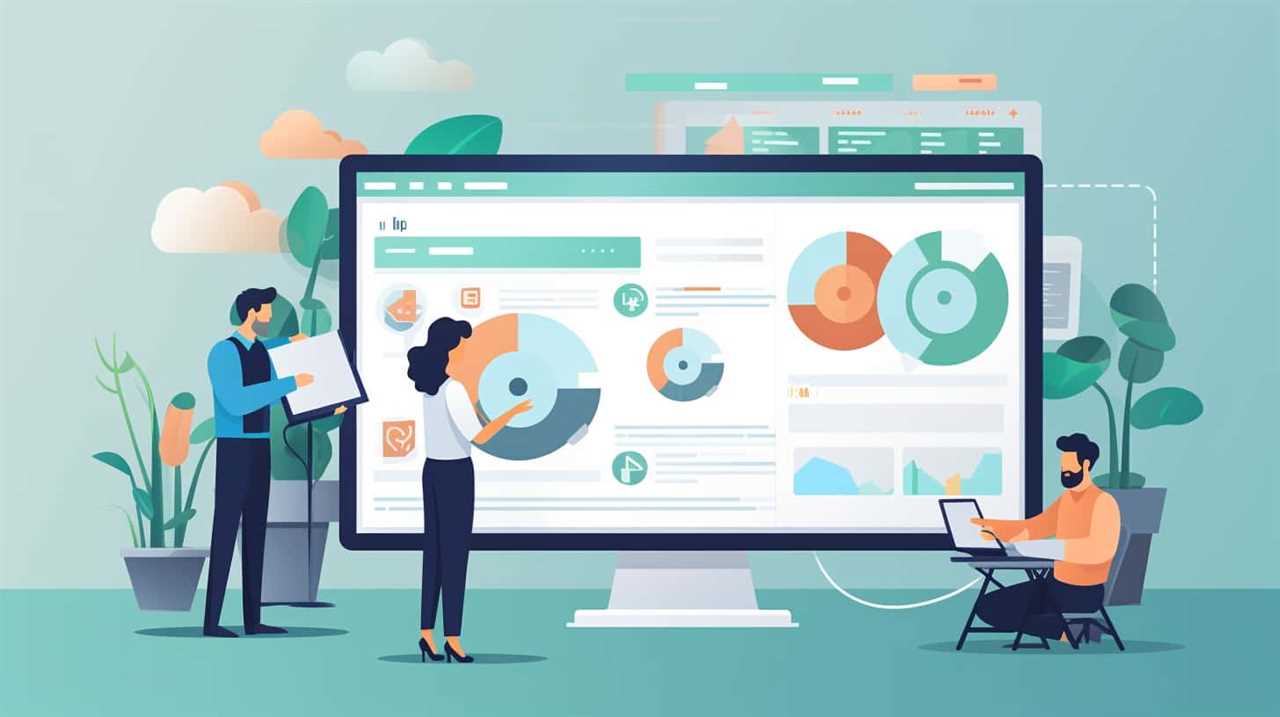Did you know that 93% of online experiences begin with a search engine?
If you’re an artisanal cheese maker looking to strengthen your web presence, you’ve come to the right place. We are here to guide you through the world of SEO and help you craft a powerful online presence that will attract cheese lovers from all over.
From keyword research to optimizing your website, we’ll show you how to master the art of SEO and take your cheese business to new heights.
Let’s get started!

Key Takeaways
- Conduct competitor analysis to understand the strengths and weaknesses of other cheese makers and identify opportunities for differentiation.
- Optimize website structure, content, and keywords to attract organic traffic and improve visibility in search engine results.
- Create compelling content for cheese lovers by showcasing the beauty and craftsmanship of artisanal cheeses through high-quality visuals and storytelling.
- Enhance user experience by providing a seamless browsing experience, engaging with the audience through social media, and leveraging influencer partnerships to tap into engaged audiences.
Understanding the Basics of SEO
In our journey to enhance our web presence as artisanal cheese makers, we must first understand the basics of SEO. Conducting competitor analysis and understanding search engine algorithms are essential components of this process.
When it comes to conducting competitor analysis, it’s crucial to identify who your competitors are in the online world. By analyzing their websites, social media presence, and keyword strategies, you can gain valuable insights into their strengths and weaknesses. This analysis will help you identify areas where you can differentiate yourself and capitalize on opportunities that your competitors may be missing.
Understanding search engine algorithms is another key aspect of SEO. Search engines like Google use complex algorithms to determine the ranking of websites in search results. By understanding these algorithms, you can optimize your website to increase its visibility and attract more organic traffic. This involves optimizing your website’s structure, content, and keywords to align with the search engine’s ranking factors.
By conducting competitor analysis and understanding search engine algorithms, you’ll be equipped with the knowledge needed to craft a powerful SEO strategy for your artisanal cheese business.

Stay tuned for our next topic, where we’ll delve deeper into the world of keyword research and optimization.
Conducting Keyword Research for Cheese Makers
To conduct keyword research for cheese makers, we analyze popular search terms that align with our artisanal cheese business. By identifying the keywords that potential customers are using to search for cheese, we can optimize our website and content to attract more organic traffic. This will ultimately help us increase our online visibility and reach a wider audience of cheese enthusiasts.
To begin our keyword research, we first conduct a cheese market analysis to identify the latest trends and consumer preferences. This allows us to understand what types of cheese are in high demand and what keywords are associated with those products. Additionally, we perform a competitor analysis to identify key players in the artisanal cheese industry. By studying their websites and content, we can gain insights into the keywords they are targeting and the strategies they are using to rank higher in search engine results.
Here is a table summarizing the key findings from our keyword research:

| Popular Search Terms | Competitor Keywords |
|---|---|
| Artisanal cheese | Sustainable cheese |
| Local cheese | Handcrafted cheese |
| Farmhouse cheese | Small-batch cheese |
| Organic cheese | Artisan cheese |
| Specialty cheese | Farmstead cheese |
Optimizing Your Website’s On-Page SEO
When it comes to optimizing our website’s on-page SEO, there are a few key points we need to keep in mind.
First, conducting thorough keyword research is essential for understanding what our target audience is searching for.
By incorporating these relevant keywords into our website’s meta tags, we can improve our visibility in search engine results and attract more organic traffic.
With these strategies in place, we can craft a stronger web presence for our artisanal cheese business.

Keyword Research Tips
Let’s dive into some essential keyword research tips for optimizing your website’s on-page SEO as artisanal cheese makers.
When it comes to attracting the right audience, using cheese-related keywords is crucial. But it’s not just about generic terms like ‘cheese’ or ‘artisanal cheese.’ To truly stand out and reach your niche audience, you need to find specific long-tail keywords that reflect the unique qualities of your cheese. Consider terms like ‘aged cheddar with a nutty flavor’ or ‘handcrafted goat cheese from local farms.’ These targeted keywords will help you rank higher in search results and attract the customers who are most likely to appreciate your artisanal offerings.
Now that we’ve covered keyword research, let’s move on to the next step: meta tag optimization.
Meta Tag Optimization
After completing keyword research, we can now focus on optimizing meta tags to enhance our website’s on-page SEO as artisanal cheese makers. Meta tags are snippets of code that provide information about a webpage to search engines. By optimizing these tags, we can improve our website’s visibility in search results and attract more organic traffic.

To help you understand the importance of meta tag optimization, here’s a table showcasing the different types of meta tags and their purpose:
| Meta Tag | Purpose | Example | |
|---|---|---|---|
| Title Tag | Defines the title of a webpage | ||
| Description Tag | Provides a brief summary of the webpage | ||
| Keyword Tag | Used to specify relevant keywords |
Creating Compelling Content for Cheese Lovers
Crafting compelling content for cheese lovers is essential for artisanal cheese makers looking to enhance their web presence. To captivate the audience and create a stronger connection with cheese enthusiasts, here are some key strategies to consider:
- Creating engaging visuals for cheese lovers: Showcase the beauty and craftsmanship of your artisanal cheeses through high-quality photographs and videos. Capture the textures, colors, and details that make your cheeses unique.
- Incorporating storytelling into cheese content: Share the stories behind your cheeses, including the inspiration, the makers, and the methods used. Connect with your audience on an emotional level by highlighting the passion and dedication that goes into each cheese.
- Educating cheese lovers: Provide informative content that helps cheese lovers deepen their knowledge and appreciation for different types of cheese. Share interesting facts, pairing suggestions, and recipes that showcase the versatility of your cheeses.
- Highlighting customer experiences: Feature testimonials and reviews from satisfied customers to build trust and credibility. Let your audience hear from others who’ve enjoyed your cheeses and their experiences with your brand.
- Offering exclusive content and promotions: Reward your loyal cheese lovers with exclusive content, such as behind-the-scenes videos or limited edition cheese releases. Additionally, offer special promotions and discounts to encourage engagement and repeat purchases.
Building High-Quality Backlinks for Cheese Websites
Building high-quality backlinks is crucial for improving the search engine optimization (SEO) of cheese websites. Backlinks are essentially links from other websites that point back to your own website. They serve as a vote of confidence in the eyes of search engines, indicating that your website is trustworthy and authoritative.
To build high-quality backlinks for your cheese website, it’s important to focus on building relationships and conducting outreach campaigns. Start by identifying websites and blogs in the food and cheese industry that have a strong online presence and a high domain authority. Reach out to them and offer to write guest posts or contribute content that’s relevant to their audience. This not only helps you build backlinks, but also establishes you as an expert in your field.

Another effective approach is to collaborate with influencers and bloggers in the cheese community. Offer to provide them with samples of your artisanal cheeses in exchange for a review or feature on their website or social media channels. This can generate valuable backlinks and also help increase your brand visibility among cheese enthusiasts.
Utilizing Local SEO Strategies for Artisanal Cheese Makers
When it comes to reaching local cheese enthusiasts, our cheese-making business needs to implement effective local SEO strategies.
By targeting local keywords and optimizing our Google My Business listing, we can improve our visibility in local search results.
Additionally, leveraging positive online reviews can help us build trust and credibility with potential customers in our area.

Targeting Local Cheese Enthusiasts
To effectively reach local cheese enthusiasts, we employ targeted local SEO strategies designed to enhance our online presence and connect with our community. By employing these strategies, we can ensure that our artisanal cheeses are discovered by those who appreciate the craft and quality that goes into every bite. Here are five key ways we target local cheese enthusiasts:
- We optimize our website for geographic targeting, ensuring that when someone searches for artisanal cheese in our area, they find us.
- We create content that showcases our participation in local cheese festivals, attracting cheese lovers in our community.
- We utilize local directories and review platforms to increase our visibility and reputation among local cheese enthusiasts.
- We engage with our community through social media, sharing updates, stories, and events related to our artisanal cheeses.
- We collaborate with local influencers and food bloggers to spread the word about our unique cheese offerings.
By implementing these strategies, we can effectively connect with our local cheese enthusiast community and build a strong online presence that drives foot traffic to our shop.
Speaking of driving foot traffic, optimizing our Google My Business listing is another crucial step in increasing our visibility in local searches.
Optimizing Google My Business
Now that we’ve discussed targeting local cheese enthusiasts, let’s delve into optimizing Google My Business and utilizing local SEO strategies to further enhance our online presence as artisanal cheese makers.

Maximizing visibility and improving our online reputation are crucial for attracting customers and building a strong brand presence. Google My Business is a powerful tool that allows us to manage how our business appears on Google Search and Maps.
By optimizing our listing, we can ensure that our business information is accurate and up-to-date, making it easier for potential customers to find us. We should optimize our listing by including relevant keywords, adding high-quality photos, and encouraging customers to leave reviews.
This won’t only help us rank higher in search results but also improve our online reputation, as positive reviews can build trust and credibility. With an optimized Google My Business listing, we can increase our visibility and reach a wider audience of cheese enthusiasts.
Leveraging Online Reviews
Leveraging online reviews is essential for enhancing the local SEO strategies of artisanal cheese makers and strengthening their web presence. Customer reviews play a crucial role in building trust and credibility for businesses. As artisanal cheese makers, we can leverage online reviews to improve customer satisfaction and manage our online reputation effectively.

Here are five ways we can do that:
- Encourage customers to leave reviews by providing exceptional service and asking for feedback.
- Respond promptly and professionally to both positive and negative reviews, showing that we value our customers’ opinions.
- Monitor online review platforms and address any issues or concerns raised by customers promptly.
- Showcase positive reviews on our website and social media platforms to highlight our reputation for excellence.
- Use feedback from reviews to make improvements to our products and services, demonstrating our commitment to continuous improvement.
Enhancing User Experience and Website Navigation
Improving website navigation and user experience is essential for artisanal cheese makers looking to strengthen their online presence. One of the first steps in enhancing user experience is by improving website design. A visually appealing and well-organized website not only attracts visitors but also encourages them to explore further. Incorporating interactive elements such as sliders, galleries, and videos can engage users and make their browsing experience more enjoyable.
When it comes to website navigation, simplicity is key. Clear and intuitive menus, along with a search bar, can help users easily find the information they’re looking for. Additionally, implementing breadcrumbs can provide users with a clear pathway to navigate back to previous pages.
Another important aspect of enhancing user experience is optimizing website loading speed. Slow loading times can frustrate users and lead to higher bounce rates. To improve loading speed, compressing images, minifying CSS and JavaScript files, and utilizing caching techniques can be effective strategies.

In conclusion, improving website design and incorporating interactive elements, along with intuitive navigation and optimized loading speed, can significantly enhance user experience. By providing a seamless and enjoyable browsing experience, artisanal cheese makers can attract more visitors to their website and ultimately strengthen their online presence.
Now, let’s delve into the next section, which discusses the importance of leveraging social media for cheese marketing.
Leveraging Social Media for Cheese Marketing
To further enhance our web presence and engage with a wider audience, how can we effectively leverage social media for cheese marketing? Social media has become a powerful tool for businesses to connect with their target audience and build brand awareness. As artisanal cheese makers, we can leverage social media platforms to showcase our products, engage with cheese enthusiasts, and ultimately drive sales. Here are five ways we can effectively utilize social media for cheese marketing:
- Create compelling content: Share visually appealing images and videos of our artisanal cheeses, highlighting their unique flavors and production process. Engage our audience with informative and entertaining posts that educate them about different types of cheese and pairings.
- Utilize social media advertising: Take advantage of targeted advertising on platforms like Facebook and Instagram. By identifying our ideal customers and creating tailored ads, we can reach a wider audience and increase brand visibility.
- Leverage influencer partnerships: Collaborate with food influencers and cheese enthusiasts who’ve a strong following on social media. By partnering with them, we can tap into their engaged audience and gain credibility and exposure for our artisanal cheeses.
- Encourage user-generated content: Encourage our customers to share their experiences with our cheeses by posting reviews, photos, and recipes. This user-generated content not only helps build trust and authenticity but also increases our online visibility through social sharing.
- Engage with our audience: Actively respond to comments, messages, and mentions on social media. By engaging with our audience, we can foster meaningful connections, address customer inquiries, and build a loyal community of cheese lovers.
Monitoring and Analyzing SEO Performance
As we continue to enhance our web presence and engage with a wider audience, we can effectively monitor and analyze the performance of our SEO efforts. Analyzing SEO performance is crucial in order to understand how well our website is ranking in search engine results pages (SERPs) and identify areas for improvement.

One important aspect of analyzing SEO performance is conducting competitor analysis. By studying our competitors’ websites, we can gain insights into their strategies and identify opportunities for differentiation. Competitor analysis techniques such as analyzing their keywords, backlink profiles, and content strategies can help us understand why they may be outperforming us in certain areas.
Additionally, we can use tools like Google Analytics to monitor key metrics such as organic traffic, bounce rate, and conversion rates. These metrics provide valuable insights into the effectiveness of our SEO efforts and help us identify areas that need improvement.
Regularly monitoring and analyzing our SEO performance allows us to make data-driven decisions and optimize our website to attract more organic traffic and improve our search engine rankings. By staying informed about the latest SEO trends and techniques, we can ensure that our web presence remains strong and competitive in the ever-evolving digital landscape.
Implementing Mobile Optimization for Cheese Websites
To ensure a seamless user experience and improve our website’s performance, we prioritize implementing mobile optimization for cheese websites. In today’s digital landscape, mobile devices are the primary means through which users access the internet. Therefore, it’s crucial for artisanal cheese makers to optimize their websites for mobile devices to stay ahead of the competition and reach a wider audience.

Here are five key strategies for implementing mobile optimization:
- Implementing responsive design: By using responsive design techniques, we can create websites that automatically adjust and adapt to different screen sizes and resolutions. This ensures that our content is displayed optimally on any device, providing a consistent and user-friendly experience.
- Utilizing mobile-friendly plugins: There are numerous plugins available that can enhance the mobile experience of our cheese websites. These plugins can optimize images, improve page load speed, and enhance navigation, resulting in a smoother and more enjoyable browsing experience for mobile users.
- Streamlining content: When optimizing for mobile, it’s important to prioritize essential content and eliminate unnecessary elements. Streamlining our content ensures that users can quickly and easily find the information they need, leading to higher engagement and conversion rates.
- Simplifying navigation: Mobile users have limited screen space, so it’s crucial to simplify the navigation menu and make it easy for users to find what they’re looking for. This can be achieved by using clear and concise menu labels, implementing drop-down menus, and utilizing mobile-friendly navigation patterns.
- Testing and optimization: Regularly testing our website’s performance on different mobile devices and browsers is essential to identify and fix any issues. By continuously optimizing our mobile experience, we can ensure that our cheese websites are providing the best possible user experience for mobile users.
Staying Up-To-Date With SEO Trends and Best Practices
Continuing our focus on optimizing mobile experiences for cheese websites, we stay up-to-date with SEO trends and best practices to ensure maximum visibility and engagement. As SEO algorithms constantly evolve, it’s crucial for artisanal cheese makers to stay updated with the latest changes. By staying ahead of the curve, we can ensure that our websites are always optimized to rank higher in search engine results.
One key trend that we’re incorporating into our SEO strategy is voice search optimization. With the rise of virtual assistants like Siri, Alexa, and Google Assistant, more and more people are using voice commands to search for information online. By optimizing our websites for voice search, we can improve our chances of being featured in voice search results and reaching a wider audience.
To stay updated with the ever-changing world of SEO, we regularly attend industry conferences, read industry blogs, and follow SEO experts on social media. This allows us to stay informed about the latest trends, algorithm updates, and best practices. We also collaborate with SEO professionals who specialize in the cheese industry to ensure that our strategies are tailored to our specific niche.

Conclusion
In conclusion, as artisanal cheese makers, it’s crucial to embrace the power of SEO to enhance our web presence.
By understanding the basics, conducting keyword research, optimizing our website, creating compelling content, building high-quality backlinks, leveraging social media, monitoring performance, implementing mobile optimization, and staying up-to-date with SEO trends, we can craft a stronger online presence.
Remember, ‘A cheese may disappoint. It may be dull, it may be naive, it may be oversophisticated. Yet it remains cheese, milk’s leap toward immortality.’ (Clifton Fadiman)
Let’s make our cheese immortal on the web!










